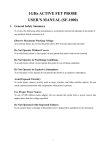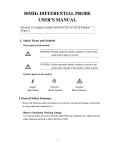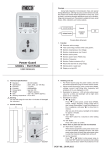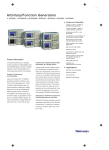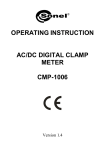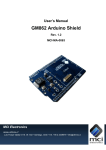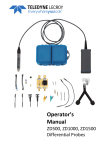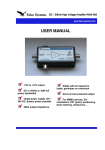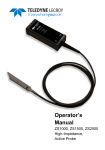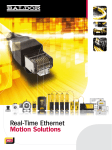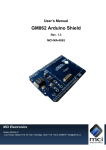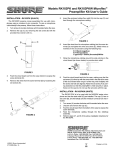Download 800MHz DIFFERENTIAL PROBE USER`S MANUAL [LDP
Transcript
800MHz DIFFERENTIAL PROBE USER’S MANUAL [LDP-800] This probe is in compliance with IEC-61010-031 CAT I, Pollution Degree 2. 1. Safety Terms and Symbols Terms appear in this manual: ________________________________________________ WARNING. Warning statements identify conditions or practice that could result in injury or loss life. ________________________________________________ CAUTION. Caution statements identify conditions or practice that could result in damage to this product or other property. Symbols appear on the product: Danger High Voltage Protective (Earth) Terminal Attention Refer to Manual 2.General Safety Summary Review the following safety precautions to avoid injury and prevent damage to this probe or any products that connected to it. Observe Maximum Working Voltage To avoid any injury, do not use the probe under the condition that the voltage between either input lead or earth is above 40Vrms CAT I. This voltage rating applies to 1/10 setting. 1 Must be Grounded This probe is grounded with the shell of BNC connector and an auxiliary grounding terminal, through the grounding conductor of the power cord of the measurement instrument. Before making connections to the input leads of this probe, ensure that the output BNC connector is attached to the BNC connector of the measurement instrument and the auxiliary grounding terminal is connected to a proper ground, while the measurement instrument is properly grounded. Do Not Operate Without Covers To avoid electric shock or fire hazard, do not operate this probe with covers removed. Do Not Operate in Wet/Damp Conditions To avoid electric shock, do not operate this probe in wet of damp conditions. Do Not Operate in Explosive Atmosphere To avoid injury or fire hazard, do not operate this probe in an explosive atmosphere. Avoid Exposed Circuit To avoid injury, remove jewelry such as rings, watches, and other metallic objects. Do not touch exposed connections and components when power is present. Use Proper Power Source To ensure this probe function well, use a 9V cells or regulated 15VDC/100mA mains adaptor or power lead. Do not operate this probe from a power source that applies more than the voltage specified. Do Not Operated With Suspected Failures If you suspect there is damage to this probe, have it inspected by qualified service personnel. 2 3. Description By enabling conventional oscilloscopes to display and measure in-circuit waveforms that are inherently differential signals, the differential probe extends the measurement capability of oscilloscopes in digital communication and high speed digital circuits. 4. Installation a. Simply plug-in the BNC output connector to the vertical input of a general purposed oscilloscope or other measurement instrument, and connects the auxiliary grounding terminal to a proper ground. The measurement instrument must have a ground referenced. b. Connect an appropriate power source to this probe and then turn it on. WARNING. To protect against electric shock, use only the accessories supplied with this probe. c. Using the appropriate probe accessories, connect the inputs to the circuits under measurement. CAUTION. This probe is to carry out differential measurement between two points on the circuit under measurement. This probe is not for electrically insulating the circuit under measurement and the measuring instrument. 3 5. Appearance The differential probe looks as follows. 1. 2. 3. Input Pins: The input pins of the differential probe can be connected directly to the circuit under tests or connected to optional accessories that come with the probes. Output Lead: The BNC output connector. Power Plug: The terminal connects to regulated 15VDC/100mA mains adaptor. 6. SMD Micro Tests Accessories Descriptions 4 Quantity MicroFlex Pincer, Black 1 MicroFlex Pincer, Red 1 Micro Test Clip, Black 1 Micro Test Clip, Red 1 MicroLead, 0.8mm J-P, 5cm, Black 1 MicroLead, 0.8mm J-P, 5cm, Red 1 MicroLead, 0.8mm J-P, 10cm Black 1 MicroLead, 0.8mm J-P, 10cm Red 1 1 Twin Pin, 16.8mm 2 Twin Pin, 12.8mm 2 Test Tip, 0.8mm 6 7. Specifications Bandwidth Attenuation Ratio Accuracy Rise Time Input Impedance Input Voltage* DC to 800MHz (-3dB) 1/10 ±2% 0.4375ns 100kΩ//2pF each side to ground - Differential Range - Common Mode Range - Absolute Max. Voltage (either input to ground) Output Voltage - Swing - Offset (typical) - Noise (typical) - Source Impedance (typical) CMRR (typical) Power Requirements ±15V (DC+peakAC) ±30V (DC+peakAC) ±40V (DC+peakAC) Ambient Operating Temperature Ambient Storage Temperature Ambient Operating Humidity Ambient Storage Humidity Length of BNC Cable Length of Input Leads Weight Dimensions (LxWxH) * ±1.5V (into 50Ω load) <±5mV 0.3mVrms 50Ω (for using 50Ω input system oscilloscope) 60dB @60Hz, 15dB @500MHZ Regulated 15VDC/100mA mains adaptor -10 to 40℃ -30 to 70℃ 25 to 85% RH 25 to 85% RH 120cm 50cm 130gms 111mm x 22mm x 14mm Voltage limit is the lesser of the DC+Peak AC and RMS values.. ** a. The supplied voltage must be less than 16V and greater than 3.3V, otherwise the probe could be damaged or can’t be operated properly. b. For wrong polarity of power sources, a built-in circuit will protect the probe and no danger or damage will occur. c. When the voltage of the cells become too low, the power indicator on the panel will change its color and then distinguish. 5 8. Derating Cure The derating curves of the absolute maximum input voltages (either input to ground) is illustrate as follows; 9. Inspection Procedure a. Connect the BNC output connector to the vertical input of a general purposed oscilloscope. b. Connect AC mains adaptor to this probe and then turn it on. c. Set the oscilloscope to DC coupling and 0.5V/div. Center the trace on the display. d. Connect the inputs of the probe to a sine-wave signal source of 100KHz and 10Vp-p. e. Then, a 100KHz sine-wave of 1 Vp-p amplitude will be displayed on the screen of the oscilloscope and this means the probe is working properly. 10. Cleaning Use a soft cloth to clean the dirt. Prevent damage to probe. a. Avoid immersing the probe. b. Avoid using abrasive cleaners. c. Avoid using chemicals contains benzene or similar solvents. Lemo® and Probus® are the registered trademarks Date: May 1,2009 6






